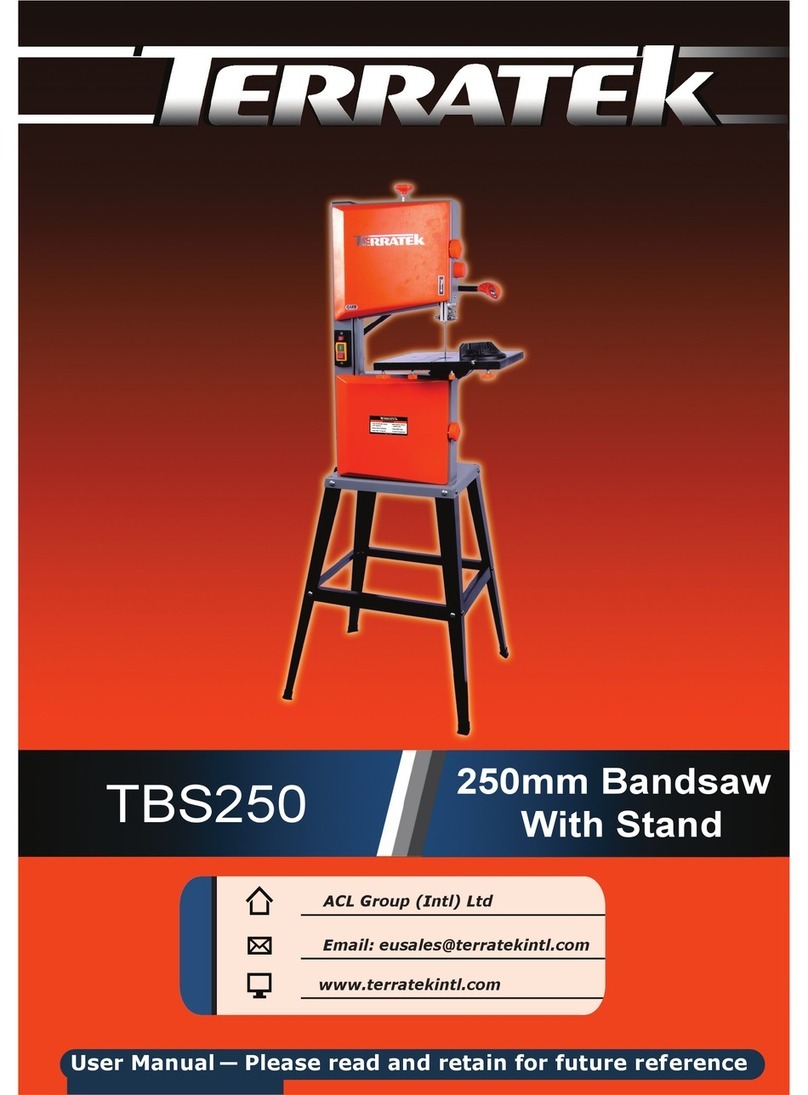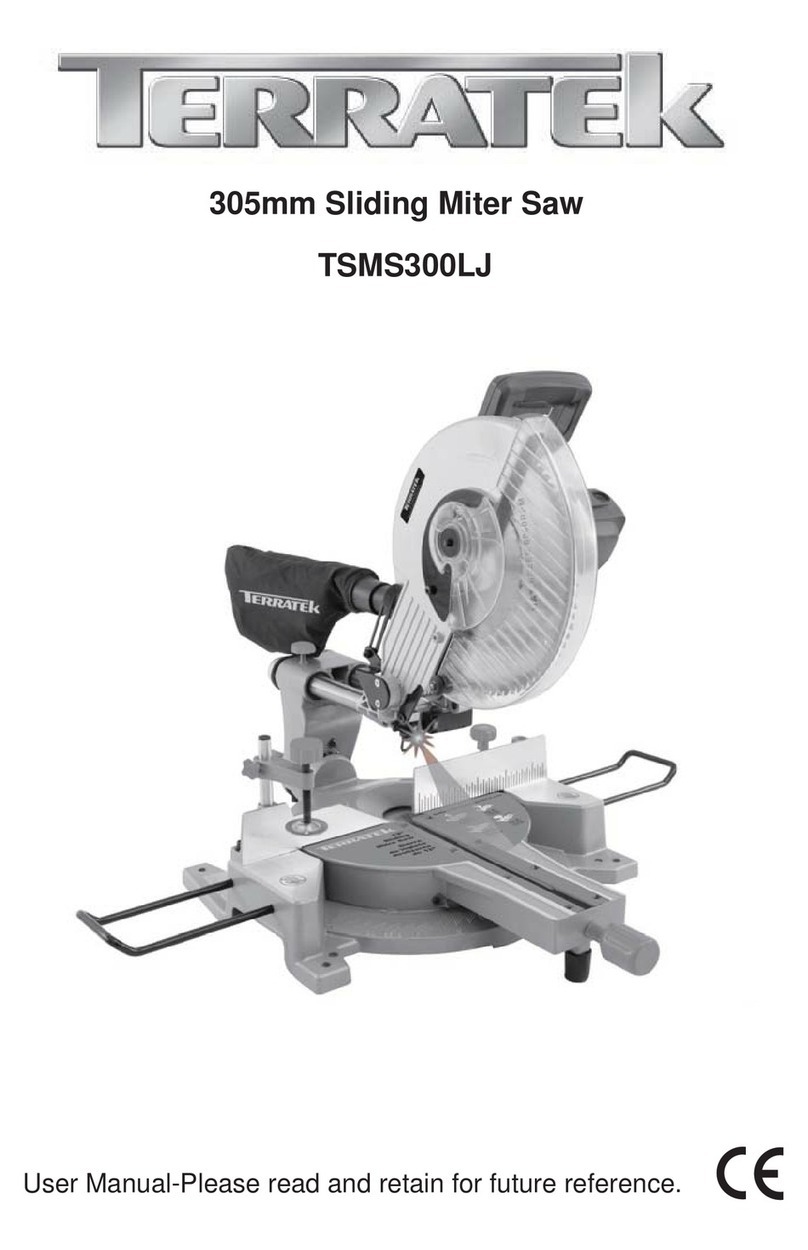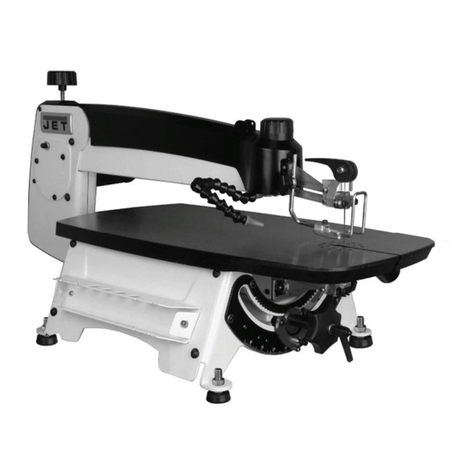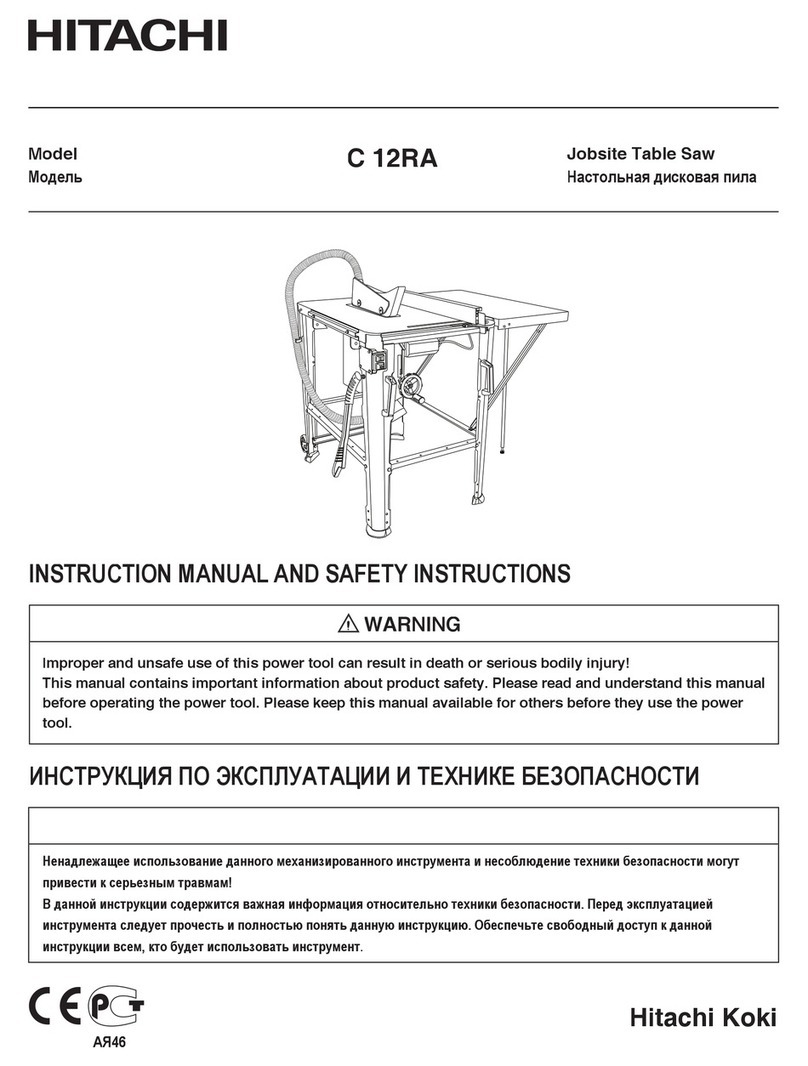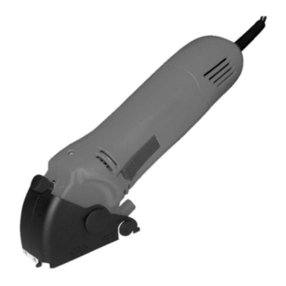Terratek T12VCS User manual

12V Li-ion Cordless Circular Saw
T12VCS
User Manual— Please read and retain for future reference.
IMPORTANT: Read all instructions before use.

Contents
Parts List
Parts List
Safety Instructions
Technical Information
Using your tool
Maintenance
Warranty
1
No. Description No. Description
1 hexagonal screw M6X16 27 spring washer 10
2 upper clamp 28 small gear
3 saw blade 29 motor
4 lower clamp 30 right housing
5 screw ST2.6x10 31 rear cover
6 clamp for blade guard 32 screw st2.6x14
7 lower blade guard 33 left housing
8 screw m5x16 34 bearing 6800
9 torsion spring 35 output shaft
10 retainer ring 36 on/off switch
11 screw ST3x16 37 lock plate
12 Upper blade guard 38 output gear
13 pin 6x28 39 wave washer 11
14 spindle locker 40 bearing 606
15 retainer spring 41 screw m3x8
16 base plate 42 spring washer 3
17 bolt m6x12 43 gear box cover
18 wave spring washer 5 44 safe button
19 angle bracket 45 spring 5.2x23.1
20 rivet 5x6 46 screw st3x14
21 washer 6.4x12x1 47 screw st2.2x10
22 angle knob 48 connector holder
23 bolt m6x14 49 12v li-ion battery pack
24 depth bracket 50 12v fast charger
25 depth lock spanner 51 hexagonal wrench
26 Nut M6

2
Exploded Assembly Diagram
NOTICE: Actual product may vary from pictures shown.

3
12
5
6
7
8
9
10
4
3
fig.1
fig.2
1. Battery pack
2. Handle
3. Switch & Safety lock
4. Spindle lock
5. Angle Locking Knob
6. Base plate
7. Lower Guard
8. Cutting depth locking lever
9. Charger
10. Blade screw Tabs
Charge indicator
Battery capacity indicator LED

4
Technical Information
Model: T12VCS
No-load Speed: 4800 /min
Arbor Size: 10mm
Saw blade: Diameter 100mm
Max. Cutting capacity: 90
o
: 26mm; 45
o
: 14mm
Battery Type: 1300 mAh Li-ion
Charger
Charging time: 1 hour
Input: 100-240V AC, 50 – 60 Hz, 27W
Output: 12.6V DC, 1500mA Max
Read this entire manual before using this product.
Failure to do so can result in serious injury. Save this manual
for future reference.
Copyright© 2013 by ACL Group (Intl) Ltd. All rights reserved. This manual or any artwork
contained herein must not be reproduced in any shape or form without the express written
consent of ACL Group (Intl) Ltd. Diagrams within this manual may not be drawn
proportionally. Due to continuing improvements, actual product may differ slightly from the
product described herein.

5
Read and Keep This Manual
Please read carefully all instructions within this manual. Failure to follow all safety warnings
can result in serious personal injury. The term “Power Tool” in all of the following warnings
refers to your mains operated (corded) or battery operated (cordless) power tool.
This symbol is to warn you of potential personal injury
hazards. Please read carefully the notes along side this warning
to avoid possible injury or death.
Keep work area clean and well lit.
Cluttered or dark areas invite accidents.
Do not operate power tools in explosive atmospheres, such as in the presence of flammable
liquids, gases or dust. Power tools create sparks which may ignite the dust or fumes.
Keep children and bystanders away while operating a power tool. Distractions can cause you
to lose control.
Important SAFETY Information
General Safety Rules
Work area safety
WARNING! Read all instructions. Failure to follow all instructions
listed below may result in electric shock, fire and/or serious injury.
The term “power tool” in all of the warnings listed refers to corded or
cordless power tools.

6
Personal safety
Power tool use and care.
Keep your power tool clean and well serviced at all times.
Never adjust or service any power tool before disconnecting from the mains electricity supply.
Always use the correct tool for the job.
Never force the tool to work harder than it is designed to do.
Never use your power tool with broken parts such as switches, guide fences or leg stands.
ALWAYS keep your power tools away from children.
Keep cutting tools sharp to ensure less stress on the motor.
Only have your power tool serviced by a qualified repair agent using manufacturers
recommended parts.
Before use, ensure that the power outlet you are using matches the plug on your power tool
and that the voltage of the outlet matches that of your power tool.
Only use grounded extension cords with power tools fitted with 3 pin plugs and if using
outdoors ensure any extension cord is suitable for outdoor use.
Always try to avoid body contact with grounded surfaces, such as radiators, cooking ranges
and any other fixed appliance with metal surfaces.
Do not expose your power tool to wet or damp conditions and NEVER use in rain.
Check regularly the power cord of your machine and any extension cord that you are using
for damage.
Do not carry or pull the machine with the power cord.
Ensure the cord is clear from hot surfaces, oil or sharp objects.
Never use your power tool whilst under the influence of alcohol, drugs or medication.
Tiredness can often cause accidents, stay alert.
Never use your power tool without the correct guards in place.
Always use approved eye protection and dust mask. Non slip safety shoes and hearing
protectors should be worn at all times when using your power tool.
Ensure any dust collecting device supplied with your machine is connected correctly before
use.
Ensure all loose clothing, long hair or jewellery is kept clear of the machine.
Before plugging your power tool into the power outlet ensure the power tool is in the OFF
position.
Check that wrenches or adjusting keys have been removed. Any wrench or key left attached
to a moving part can result in injury.
Electrical safety

7
GENERAL SAFETY INSTRUCTIONS
Read this owner's manual completely and make sure you understand all of its safety
guidelines.
WARNING:
For your own safety read Instruction Manual before operating your power tool.
A) Wear eye protection.
B) Keep hands out of the path of cutting tools.
C) Do not operate tool without guards in place.
D) Do not perform any operation freehand.
E) Never reach around cutting tools.
F) Turn off tool and wait for cutting tools to stop before moving work piece or changing settings.
G) Disconnect power (or unplug tool) before changing cutting tools or servicing.
1. KEEP GUARDS IN PLACE
and in working order.
2. REMOVE ADJUSTING KEYS & WRENCHES.
Before turning on the power tool, make sure
the keys and adjusting wrenches have been removed.
3. KEEP WORK AREA CLEAN.
Cluttered areas and benches invite accidents.
4. ALWAYS REMAIN ALERT WHEN THE TOOL IS IN USE.
Inattention on the part of the
operator may lead to serious injury.
5. DON’T USE IN A DANGEROUS ENVIRONMENT.
Don’t use power tools in damp or wet
locations or expose them to rain. Keep work area well lit.
6. KEEP CHILDREN AWAY.
All visitors should remain at a safe distance from work area.
7. MAKE WORKSHOP CHILD-PROOF
with padlocks, master switches or by removing
starter keys.
8. USE THE RIGHT TOOL.
Don’t force a tool or attachment to do a job for which it was not
designed.
Service
Have your power tool serviced by a qualified repair person using only identical
replacement parts.
This will ensure that the safety of the power tool is maintained.
Develop a periodic maintenance schedule for your tool. When cleaning a tool be
careful not to disassemble any portion of the tool since internal wires may be
misplaced or pinched or safety guard return springs may be improperly mounted.
Certain cleaning agents such as gasoline, carbon tetrachloride, ammonia, etc. may damage
plastic parts.
When servicing a tool, use only identical replacement parts. Follow instructions in
the Maintenance section of this manual.
Use of unauthorized parts or failure to follow
Maintenance Instructions may create a risk of electric shock or injury.

8
9.
USE THE PROPER EXTENSION CORD.
Make sure your extension cord is in good
condition. When using an extension cord, be sure to use one heavy enough to carry the
current your product will draw. An undersized cord will cause a drop in line voltage resulting
in loss of power and overheating. If in doubt, use the next heavier gauge. The smaller the
gauge number, the heavier the cord.
10.
DON’T FORCE THE TOOL.
It has been designed to operate at maximum safety and
performance levels.
11.
DO NOT FORCE THE MATERIAL BEING CUT.
Always let the tool cut at its own speed.
12.
WEAR PROPER APPAREL.
Do not wear loose clothing, neckties, rings, bracelets or other
jewelry which may get caught in moving parts. Non-slip foot wear is recommended. Wear
protective hair covering if you have long hair.
13.
ALWAYS USE SAFETY GLASSES.
Also use face or dust mask for commercial cutting
operations. Everyday eyeglasses only have impact-resistant lenses, they are NOT safety
glasses.
14.
SECURE WORK.
Use clamps or a vise instead of your hand to hold work when practical.
This safetyprecaution allows for proper tool operation using both hands.
15.
DON’T OVERREACH.
Keep proper footing and balance at all times.
16.
MAINTAIN TOOLS WITH CARE.
Keep tools clean and in good working condition for
maximum safety performance. Follow instructions for lubricating and changing accessories.
17.
DISCONNECT TOOLS BEFORE SERVICING
– when changing accessories, such as
blades, bits, cutters, etc.
18.
REDUCE THE RISK OF UNINTENTIONAL STARTING.
Make sure switch is in OFF
position before plugging in.
19.
USE RECOMMENDED ACCESSORIES.
Consult the owner’s manual for recommended
accessories. The use of improper accessories may increase risk of injury.
20.
MAKE SURE YOU USE THE CORRECT TOOL
for the job you are doing.
21.
NEVER STAND ON TOOL.
Serious injury could occur if the tool is tipped or if the cutting
tool is unintentionally contacted.
22.
CHECK DAMAGED PARTS.
Before further use of the tool, damaged part(s), (i.e., guard)
should be carefully checked to determine that it will operate properly and perform its intended
function. Check for alignment of moving parts, binding of moving parts, breakage of parts,
mounting and any other condition that may affect the tools operation. A guard or other part
that is damaged should be properly repaired or replaced.
23. Replace damaged blades/cutters immediately.
DO NOT USE DAMAGED BLADES/CUTTERS.
They may cause bodily injury.
24.
DIRECTION OF FEED.
Feed work into the blade/cutter against the direction of rotation of
the blade/cutter only.
25.
DO NOT ALTER THE PLUG.

9
26.
NEVER LEAVE TOOL RUNNING UNATTENDED.
Turn power off. Don’t leave tool until it
comes to a complete stop.
27. Double Insulation eliminates the need for the three wire grounded power cord and
grounded power supply system.
This power tool is supplied with all the relevant safety guards and features, it should be
checked before every operation, this manual should be read and kept in a safe place. Whilst
we warn of all the possible risks attached to using power tools any operator must have read
and understood the manual and apply their own caution and common sense when using this
power tool.
Following this guide will greatly reduce your risk of electric shock or injury.
Only use qualified repair agents to service this power tool.
Only use qualified electrician to repair any damaged wiring.
NEVER remove the grounding prong from the power tool or extension cord.
ĚĚŝƟŽŶĂůƐĂĨĞƚLJ/ŶƐƚƌƵĐƟŽŶƐ
Cordless Circular Saw
Danger:
a) Do not reach into the cutting area or touch the saw blade. Hold the additional
handle or the motor casing with your other hand.
If you hold the circular saw in both
hands, the saw blade cannot injure them.
b) Do not reach under the workpiece.
The guard hood cannot protect you from the saw
blade under the
c) Adjust the cutting depth to the thickness of the workpiece.
Less than one full tooth
height should be visible under the workpiece.

10
d) Never hold the workpiece you wish to saw in your hand or on your leg. Secure the
workpiece on a sturdy surface.
It is important that you secure the workpiece well to
minimize the danger of body contact, the saw blade jamming or loss of control.
e) Hold the tool only by the insulated handles when carrying out work during which
the cutting tool could strike concealed power cables or its own cable.
Contact with a
live cable will also make the metal parts of the appliance live and will cause an electric shock.
f) Always use a stop or a straight edge when carrying out longitudinal cuts.
This will
improve your cutting accuracy and reduce the possibility of the saw blade jamming.
g) Always use saw blades of the correct size and with a suitable mounting hole
(diamond shaped or round).
Saw blades that do not match the mounting parts of the saw
will not rotate truly and will result in a loss of control.
h) Never use damaged or incorrect saw blade washers or screws.
The saw blade
washers and screws have been specifially designed for your saw to ensure perfect performance
and operational safety.
a) Hold the saw firmly in both hands and hold your arms in a position in which you
can withstand the recoil forces. Always hold the saw blade to one side. Never hold
the saw blade in a straight line with your body.
In the event of a recoil the circular saw
may leap backwards, but the user can still overcome the recoil forces if he has taken suitable
precautions.
b) If the saw blade jams or the sawing operation is interrupted for any reason,
release the ON/OFF switch and hold the saw steady in the workpiece until the saw
blade has reached a complete stop. Never attempt to take the saw out of the
workpiece or to pull it backwards whilst the saw blade is moving or there is a
possibility of a recoil.
Find the reason for the blade jamming and rectify it by suitable
means.
Additional safety instructions for all saws
Causes of and ways to avoid recoil:
1. Recoil is the sudden reaction resulting from a caught, jammed or incorrectly aligned saw
blade which may result in the saw leaping out of the workpiece out of control and towards
the operator.
2. If the saw blade becomes caught or jammed in closing saw gap, it will lock and the power
of the motor will cause the saw to leap backwards towards the operator.
3. If the saw blade is twisted or incorrectly aligned in the cut, the teeth in the rear saw blade
edge may become caught in the surface of the workpiece, which results in the saw blade
leaping out of the saw gap and the saw leaping towards the operator.
A recoil is the result of incorrect or wrong use of the saw. It can be prevented by suitable
precautions, as described below.

11
c) If you wish to restart a saw that is already in the workpiece, center the saw blade
in the saw gap and check that the saw’s teeth are not caught in the workpiece.
If the
saw blade is jammed it may move out of the workpiece or cause a recoil when the saw is
restarted.
d) Support large panels to reduce the risk of a recoil by a jammed saw blade.
Large
panels may sag under their own weight. Panels must be supported on both sides both near
the saw gap and also at the edge.
e) Do not use blunt or damaged saw blades.
Saw blades with blunt or incorrectly
aligned teeth will create increased friction due to the saw gap being too small. In addition the
saw blade may also jam and cause recoil.
f) Secure the cutting depth and cutting angle settings before starting to saw.
If the
settings change as you are sawing, the saw blade may jam and cause recoil.
g) Be particularly careful when carrying out a “plunge cut” in a concealed area such
as an existing wall.
The plunge-cutting saw blade may block when sawing into concealed
objects and thus cause recoil.
Safety instructions for saws with a swing guard hood
a) Check that the bottom safety hood closes perfectly before using the appliance.
Do not use the saw if the bottom safety hood does not move freely and does not
close immediately. Never clamp or tie the bottom guard hood in open position.
If you
drop the saw by accident the bottom guard hood may become bent. Open the safety hood
with the lever and ensure that it moves freely and will not come into contact with the saw
blade or other parts regardless of the cutting angle and depth.
b) Check the function of the spring on the bottom safety hood. Have the appliance
serviced before you use it if the bottom safety hood and spring are not in perfect
working order.
Damaged parts, sticky deposits or accumulations of chips will result in the
bottom guard hood working with a delay.
c) Open the bottom safety hood by hand only for special cuts, such as “immersion
and angle cuts”. Open the bottom safety hood using the lever and release the lever
again as soon as the saw blade has engaged in the workpiece.
The bottom safety hood
must operate automatically for all other sawing work.
d) Do not place the saw on a workbench or on the floor unless the bottom guard
hood is covering the blade.
An unprotected, moving saw blade will cause the saw to move
opposite to the sawing direction and saw through anything in its way. Remember that the saw
takes a little time to slow down and stop.

12
Wear hearing protection.
Exposure to noise can cause hearing loss.
Always wear eye protection.
Use appropriate detectors to determine if utility lines are hidden in the work area
or call the local utility company for assistance.
Contact with electric lines can lead to fire
and electric shock. Damaging a gas line can lead to explosion. Cutting into a water line causes
property damage or may cause an electric shock.
Switch off the power tool immediately if the tool insert jams. Be prepared for high
reaction torque that can cause kickback.
The tool insert jams when the power tool is
subject to overload.or it becomes wedged in the workpiece.
Hold power tool by the insulated gripping surfaces, when performing an operation
where the cutting tool may run into hidden wiring.
Contact with a “live” wire will make
exposed metal parts of the tool “live” and shock the operator.
When working with the machine, always hold it firmly with both hands and provide
for a secure stance.
The power tool is guided more securely with both hands.
Keep your workplace clean.
Blends of materials are particularly dangerous. Dust
from light alloys can burn or explode.
Always wait until the machine has come to a complete stop before placing it down.
The tool insert can jam and lead to loss of control over the power tool.
Before any work on the machine (e. g., maintenance, tool change, etc.) as well as
during transport and storage, set the rotational direction switch to the centre
position.
Unintentional actuation of the On/Off switch can lead to injuries.
Avoid unintentional switching on. Ensure the On/Off switch is in the off position
before plugging to outlet (corded tools).
Carrying the power tool with your finger on the
On/Off switch that have the switch on invites accidents.
Protect the power tool against heat, e. g., also against continuous sun irradiation
and fire.
Check any parts concerned.
Clean such parts or replace them, if required.

13
V…………………………volts
A…………………………amperes
Hz……………………….hertz
~…………………….….alternating current
…/m……………….....revolutions per minute
.....................class II construction (double insulated)
Kg………………………..kilograms
n
0
………………………..No load speed
……………….….....Conforms to European Harmonised New Approach Directives.
DC ………………..…….Direct Current
Battery use and care
A battery operated tool with integral batteries or a separate battery pack must
be recharged only with the specified charger for the battery.
A charger that may be suitable for one type of battery may create a risk of fire when used
with another battery.
Use battery operated tool only with specifically designed battery pack.
Use of any other batteries may create a risk of fire.
NEVER
place hands or other body parts near the drill bit or chuck during operation.
Hold the tool by its handle only. Because the tool operates by battery power, be aware of
the fact that it can begin to operate at any time.
Charging the battery pack
(Fig. 2)
Note:
Newly purchased Batteries are not fully charged and must be charged before using
in your cordless tool(s).
1. Plug the battery charger into the proper AC voltage source.
2. Insert the battery pack so that the ribs on the battery pack slide into the grooves on the
battery charger. Insert the cartridge fully into the charger. (Fig.2)
3. When the battery pack is inserted, the Red LED will light, indicating the charger has
started the charging cycle. A Green light will indicate the battery is completely charged
and should be removed from the charger. (Fig.2)
4. After charging, unplug the charger from the power source.
5. Other tips for extending Battery life: Do not store batteries completely discharged.
Charge them fully before storing.
Symbols
IMPORTANT:
Some of the following symbols may be used on your tool.

14
Overload Protection
The power cutter is fitted with an overload/overheat protection device. When the tool is
forced to work at an excessive load, the protection device will be activated automatically
to disconnect the power supply. If this occurs, switch off the tool and switch on again to
resume the work, make sure to apply only suitable workload to the tool. When the tool
works under heavy load for a long period of time, the temperature of the tool or battery
pack will increase significantly. The protection device will be activated at a preset temperature
to protect both the tool and the battery. If this occurs, switch off the tool and wait until it
cools down to ambient temperature and resume work.
Note:
when the voltage of battery pack is dropped to 7.5V, the protection device will also be
activated. In this case, remove the battery pack and fully charge it before reuse.
WARNING: Improper use of the battery or battery charger can lead to serious injury.
To avoid these injuries:
A)
NEVER
disassemble the battery.
B)
NEVER
incinerate the battery, even if it is damaged or is completely worn out. The battery
can explode in a fire.
C)
NEVER
short-circuit the battery.
D)
NEVER
insert any objects into the battery charger’s air vents. Electric shock or damage
to the battery charger may result.
E)
NEVER
charge outdoors. Keep the battery away from direct sunlight and use only where
there is low humidity and good ventilation.
F)
NEVER
charge when the temperature is below 32°F (0°C) or above 104°F (40°C).
G)
NEVER
connect two battery chargers together.
H)
NEVER
insert foreign objects into the hole for the battery or the battery charger.
I)
NEVER
use a booster transformer when charging.
J)
NEVER
use an engine generator or DC power to charge.
K)
NEVER
store the battery or battery charger in places where the temperature may reach or
exceed 104°F (40°C).
L)
ALWAYS
operate charger on standard household electrical power (230 volts). Using the
charger on any other voltage may overheat and damage the charger.
M)
ALWAYS
wait at least 15 minutes between charges to avoid overheating the charger.
N)
ALWAYS
disconnect the power cord from its receptacle when the charger is not in use.

15
ADDITIONAL PRECAUTIONS FOR CHARGER & BATTERY PACK
1. Do not charge battery pack when temperature is below 10°C (50°F) or above 40°C (104°F).
2. Do not attempt to use a step-up transformer, an engine generator or DC power receptacle.
3. Do not allow anything to cover or clog the charger vents.
4. Always protect the battery terminals when the battery pack is not used.
5. Do not short the battery pack.
6. Do not touch the terminals with any conductive material.
7. Avoid storing battery cartridge in a container with other metal objects such as nails, coins,
etc.
8. Do not expose battery pack to water or rain.
Warning! A battery short can cause a large current flow, overheating, possible burns and
even a breakdown.
9. Do not store the tool and Battery pack in locations where the temperature may reach or
exceed 50°C (122°F).
10. Do not incinerate the Battery pack even if it is severely damaged or is completely worn out.
The battery pack can explode in a fire. (Proper disposal is a must, check with your local
recycling center)
11. Be careful not to drop, shake or strike battery.
12. Do not charge inside a box or container of any kind. The battery must be placed in a
ventilated area during charging.
Specific Safety Rules
1) Hold power tools by insulated gripping surfaces when performing an operation where the
cutting tool may contact hidden wiring.
Contact with a “live” wire will make exposed metal parts of the tool “live” and shock the
operator.
2) Wear ear and eye protection. To avoid serious injuries.
3) If the cutter becomes jammed, immediately turn the trigger switch off to prevent an
overload which can damage the battery pack or motor. Use reverse to loosen jammed bits.
4) Do not touch the rotating parts to avoid injury.
5) Do not use the tool continuously for a long period of time. Stop using the tool from time to
time to avoid overheating of the motor.
6) Do not drop the tool.

16
Unpacking
Carefully remove the product and any accessories from the box. Make sure that all items
listed in the packing list are included.
Package contents
A) 12V Li-ion cordless circular saw
B) User manual
C) Allen key (1 piece)
Operation
CAUTION! Always be sure that the tool is switched off before assembly, including
insertion or removal of the battery pack.
Installing or removing battery pack.
1. To remove the battery pack, withdraw it from the tool while depressing the tabs (Fig.2)
on both sides of the battery pack.
2. To insert the battery pack, align the ribs on the top of the battery with the grooves in
the housing and slide it into place. Always insert it all the way until it locks in place with a
little click. Lightly pull on the battery pack to ensure it is locked into place and will not
accidentally fall out of the tool, causing an injury.
3. Do not use force when inserting the battery pack. If the battery does not slide in easily,
it is not being inserted correctly.
Changing the blade
IMPORTANT: remove battery
1. Place the saw on the side of a flat surface.
2. Rotate the saw blade by hand while depressing the Spindle Lock (Fig.1-4) until the blade
is locked. Loosen the blade clamping screw (Fig.1-10) with the hex key provided.
3. Remove the blade clamp screw and outer flange.
4. Lift the lower guard (Fig.1-7) with the lower guard lever and remove the blade.
5. Mount the new saw blade onto the spindle.
6. Make sure the saw teeth and arrow on the blade are pointing the same direction as the
arrow on the lower guard.
7. Reinstall the outer flange and tighten it with blade clamp screw.
8. Make sure the saw blade can run freely by turning the blade by hand.

17
Angle Setting
1. Loosen the angle locking knob (Fig.1-5).
2. Adjust the base to the desired angle between 0º and 45º.
3. Tighten the angle locking knob.
General cut
Always wait the tool to reach its full speed before start cutting. Never force the saw but
maintain a light and continuous pressure after completing the cut, allow the saw to come to
a complete stop. If the cutting is interrupted, resume the cut by allowing the blade to reach
full speed and then reenter the cut slowly.
When cutting across the grain, the fibers of the wood will have a tendency to lift and tear,
moving the saw slowly to minimize this effect.
Pocket cut
Set the depth adjustment based on the thickness of the line drawing for the cut. Raise the
lower guard by using the lower guide lever.
With the blade is barely above the material to be cut, start the saw and allow the blade to
attain full speed. Using the front end of the shoe as a pivot point, lower the blade gradually
onto the material which being cut. Release the lower guard when the blade starts to cutting.
When the shoe is resting flat on the surface being cut, proceed cutting in a forward direction
to the end of the cut. Allow the blade to come to a full stop before removing it from the cut.
Never pull the saw backward since the blade will climb out of the cut, as a result, kickback may
occur. Turn the saw around and finish the cut in a normal manner, sawing forward. Use a jig
saw or a hand saw to finish the cut in the corners if it is necessary.
Depth Setting
1. Loosen the depth adjustment screw using the cutting depth locking lever (Fig.1-8).
2. Hold the base plate flat against the body of the work piece and raise or lower the body of
the saw until the blade is at the right depth.
3. Tighten the cutting depth locking lever.
Note: for an optimal quality cut, the saw blade should not extend more than 3 mm below the
workpiece.
Switching On/Off
Note: Before engaging the on/off switch, check the saw blade to see if it is fitted properly
and runs smoothly, and the blade clamp screw is well tightened.
1. To start the tool, push the safety lock to either side and squeeze the switch trigger.
2. Release the trigger to turn the tool off.

18
Disposal
Power tools, accessories and packaging should be sorted for environmentally-friendly recycling.
Only for EC countries:
Do not dispose of power tools into household waste!
According to the European Directive 2002/96/EC on waste electrical and
electronic equipment and its incorporation into national right, products
that are no longer suitable for use must beseparately collected and sent
for recovery in an environmentally-friendly manner.
Li-Ion:
Do not dispose of battery packs/batteries into household waste, water
or fire. Battery
packs/batteries must be collected, recycled or disposed of in an
environmentally-friendly way.
Only for EC countries:
Defective or dead batteries must be recycled according to the directive 2006/66/EC.
Battery packs/batteries:
Disposal of the exhausted battery
WARNING:
Do not dispose of the exhausted battery. The battery must explode if
it is incinerated. The product that you have purchased contains a rechargeable
battery. The battery is recyclable. At the end of its useful life, under various state
and local laws, it may be illegal to dispose of this battery into the municipal waste
stream. Check with your local solid waste officials for details in your area for
recycling options or proper disposal.
LED Capacity indicator: (Fig.2)
$OOWKUHH/('ĻVDUHRQ!
7ZR/('ĻVDUHRQ!
2QH/('LVRQ
Once only the one LED is lit, the battery must be re-charged.
MAX 50ºC
Li-Ion

19
Accessories
CAUTION:
Use only accessories or attachments recommended for use with your Terratek tool
specified in this manual. The use of any other accessories or attachments might present a risk
of injury to persons. Only use accessory or attachment for its stated purpose.
Maintenance
1. Keep all safety devices, air vents and the motor housing free of dirt and dust as far as
possible. Wipe the equipment with a clean cloth or blow it with compressed air at low pressure.
2. We recommend that you clean the device immediately each time you have finished using it.
3. Clean the equipment regularly with a moist cloth and some soft soap. Do not use cleaning
agents or solvents; these could attack the plastic parts of the equipment. Ensure that no water
can seep into the device.
General Maintenance
1. Keep the air vents free from obstruction and clean regularly.
2. Check regularly for any dust particles entering the grills around the motor and the switch.
Use a soft brush to remove any dust particles. Wear safety glasses to protect your eyes whilst
cleaning.
3. Monitor the dust bag (if equipped) and empty when approximately half full. Always empty
into an appropriate container. REMEMBER: dust can be hot and cause fire.
4. If the cutting tool has become dull, replace it. Dull cutters will cause increased tear-out and
ragged edges on the cuts.
5. Lubricate all moving parts at regular intervals.
6. To clean the body of the power tool, only use a soft damp cloth. Do NOT immerse in water.
A mild detergent can be used but NOT petrol or any alcohol based product.
7. Should the power cord become damaged only allow a fully qualified electrician to replace
or repair.
Table of contents
Other Terratek Saw manuals
Popular Saw manuals by other brands

Chicago Electric
Chicago Electric 94626 operating instructions
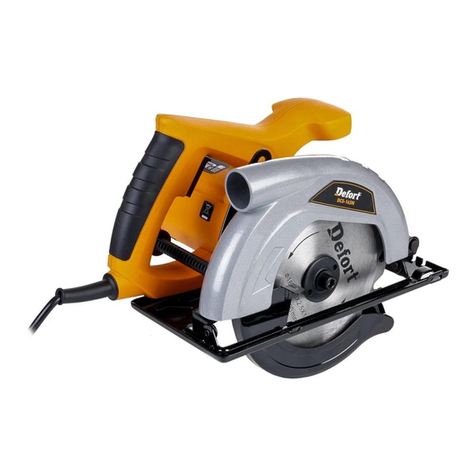
SBM
SBM Defort DCS-165N user manual

Ferm
Ferm CSM1043 Original instructions
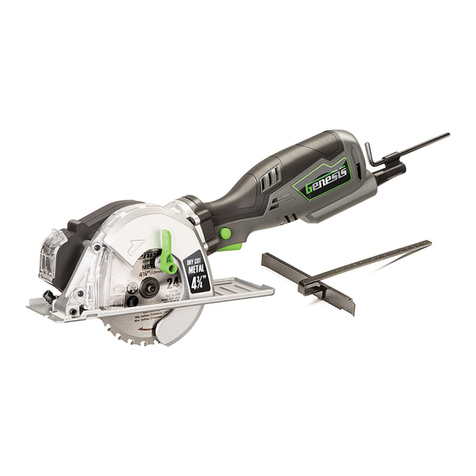
Genesis
Genesis GMCS547C Operator's manual

Bosch
Bosch GSA 18 V-LI Professional Original instructions

Central Machinery
Central Machinery 94652 Assembly and operating instructions
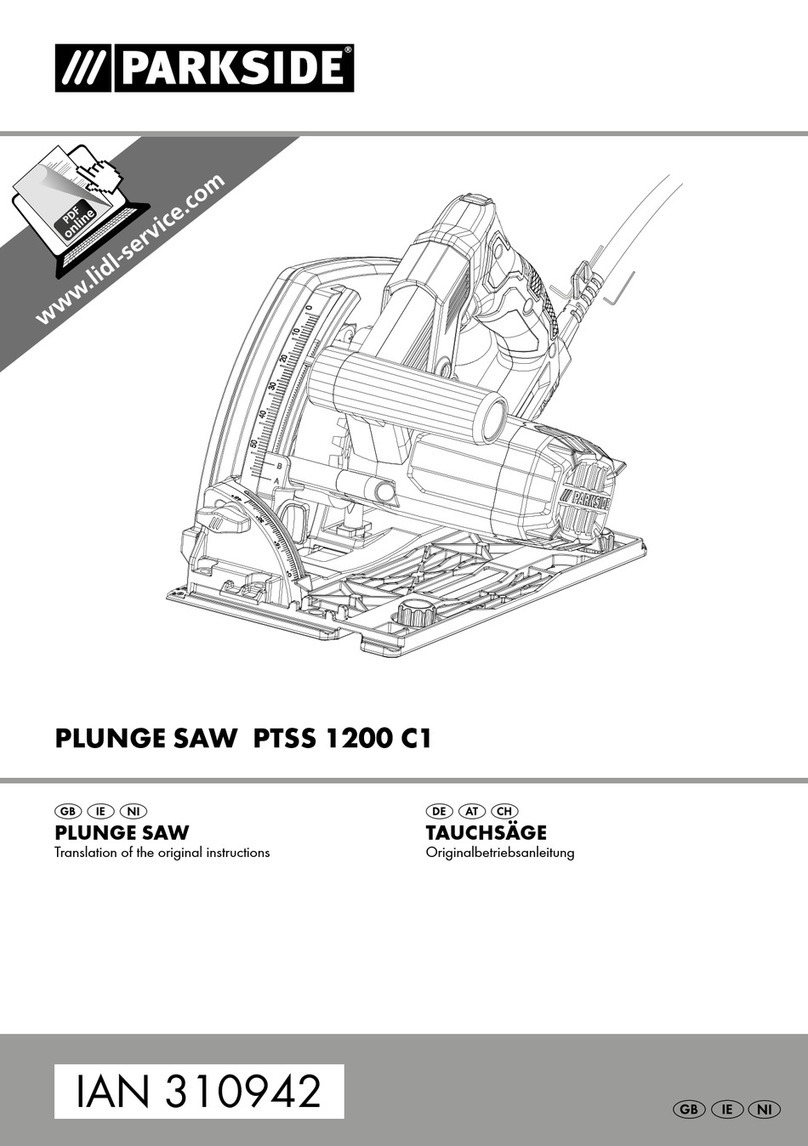
Parkside
Parkside PTSS 1200 C1 instruction manual
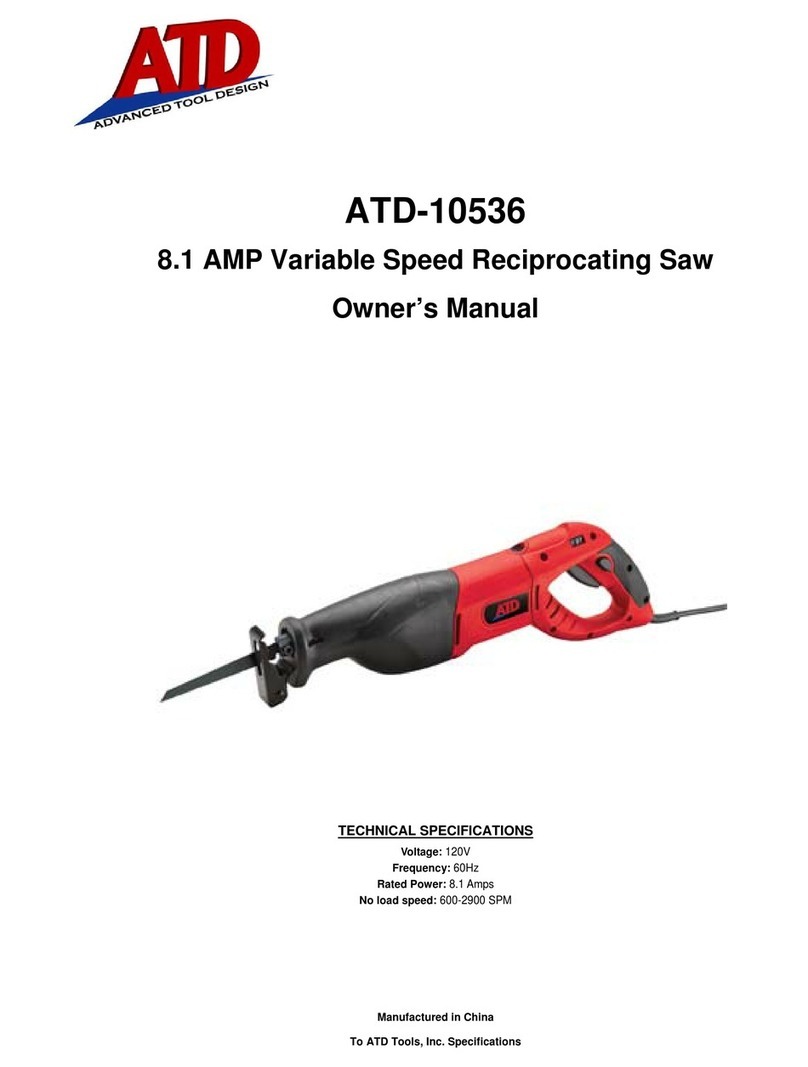
ATD Tools
ATD Tools ATD-10536 owner's manual

Mafell
Mafell 91B401 Translation of the original operating instructions
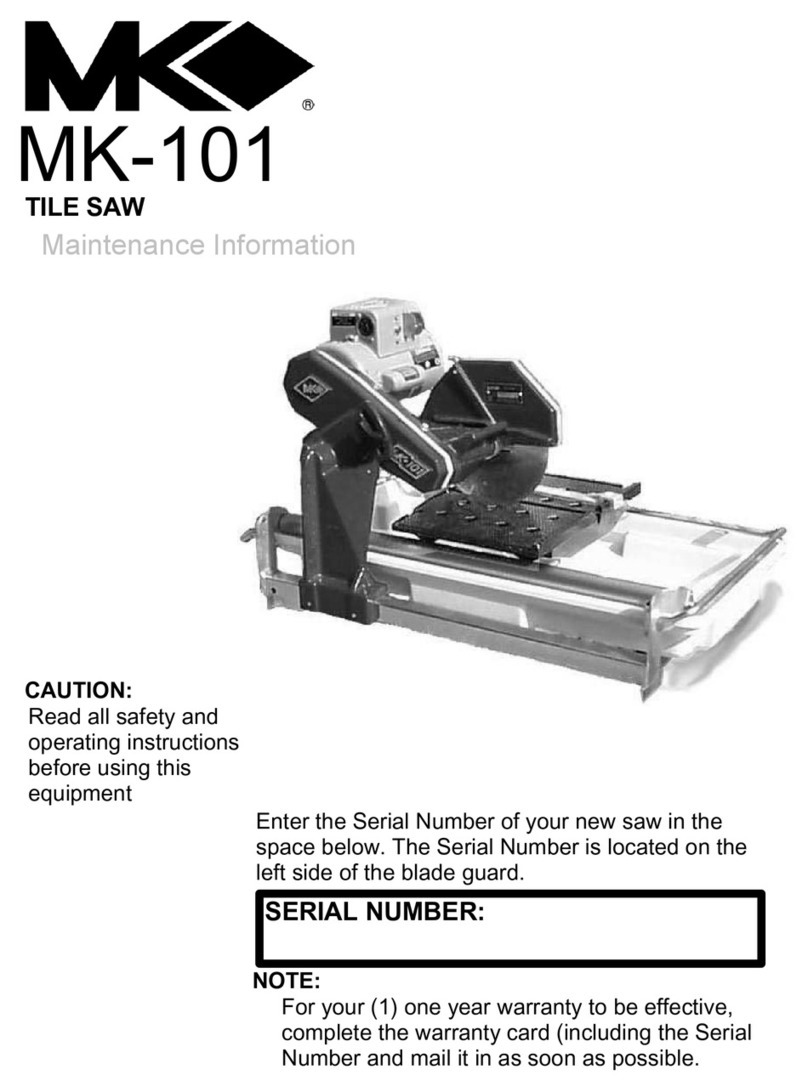
MK
MK MK-101 Maintenance information
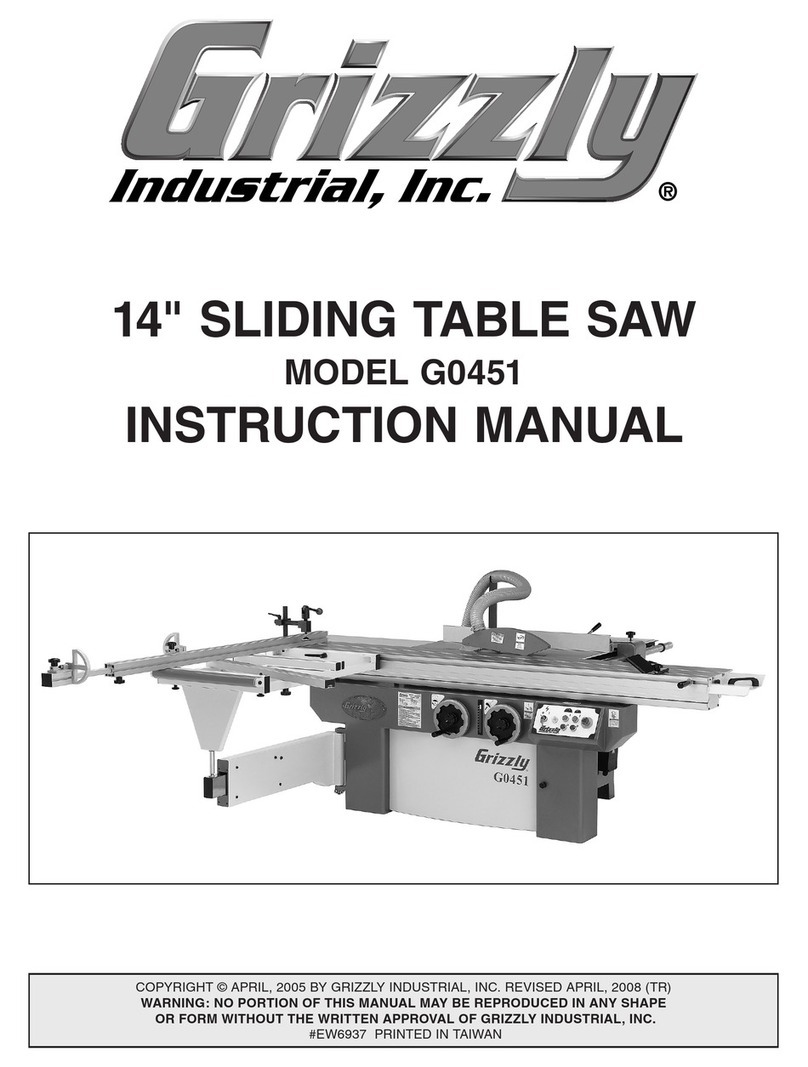
Grizzly
Grizzly G0451 instruction manual
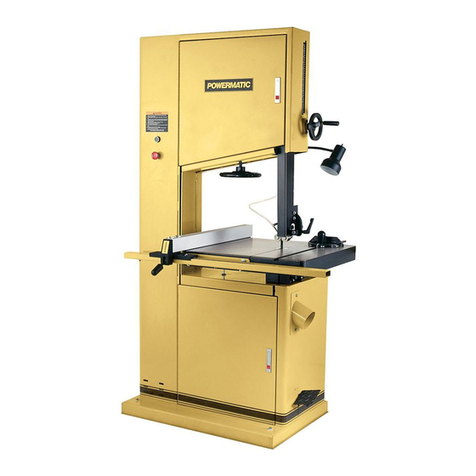
Powermatic
Powermatic 2013 Operating instructions and parts manual
